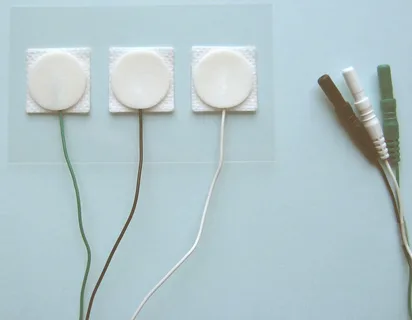What Factors Should Consider When Choosing Electrodes for Physiotherapy

The electrodes do a really important job in physiotherapy transmitting the signals from the body to the device where the therapy is involved. The electrode choice is multiplexed by numerous factors such as maximizing effectiveness and meeting the patients’ comfort needs for physiotherapy. Now, let us look at the major aspects doctors and therapists should keep in mind when deciding on the kind of electrodes for physiotherapy sessions.
Electrode Composition and Material
The selection of the electrode material and its construction dictate its conductivity and the endurance of it. Plated electrodes are typically constructed from materials such as silver chloride, carbon rubber, or stainless steel. Silver chloride electrodes perform superbly because of the conductivity they provide and are often the preferred type of electrode in terms of their stability and the long-term durability of their functioning. Carbon rubber electrodes are a very economical option for applications that demand short-term use, but for those applications that involve long-term use, the stainless steel electrodes are the best as they never fail.
Size and Shape of Electrodes
The electrodes’ dimensions can be altered based on the purpose, i.e. the area of the body to be treated, and the therapy modality involved. Big electrodes are often found to be appropriate for larger muscle groups or areas that apply or need deep penetration, but smaller electrodes are meant for localized procedures or areas where depth is not the issue. Consequently, electrodes are available in different shapes ranging from circular, rectangular, and oval fit, hence making practitioners choose the appropriate shape for each targeted area.
Adhesive Quality
The adhesion property of electrodes acts as a critical consideration for the development of successful therapy; as it keeps electrodes intact on the body while therapy is being conducted. A great adhesive agent ensures that the electrode stays in place and needs no readjustment whatsoever so that the best signal can be reached. It reduces the need for readjustment and improves signal transmission. The selection of hook electrodes with hypoallergenic adhesive is very crucial in order to avoid the possibility of skin irritation or allergic reaction to the adhesive, especially in patients with sensitive skin.
Conductivity and Impedance
The conductivity of electrodes is the most determining factor responsible for their ability to transfer electrical signals efficiently. The ability to carry a strong signal is the most critical feature for both therapy effectiveness and precise monitoring. Also, this parameter, meaning the amount of electric current that is resistant, has to be kept low in order to not distort the signal and, thus, provide favorable therapy effects. Healthcare professionals must select an electrode with the appropriate electrical conductivity feature and impedance to achieve the best possible treatment result.
Compatibility with Electrode Gel
This gel is frequently used carefully and close to electrodes in order to achieve good conduction and seamless signal transmission. Psychotherapy regarding the electrode style is inappropriate if it does not match the electrode gel. Some electrodes may need certain forms of gels which will ensure the highest efficiency, other ones were designed to function with most gel formulations. The physicians should choose the electrodes and the ecg electrode gel to be compostable to achieve the desired therapeutic outcomes.
Longevity and Reusability
The long life span and ability of electrodes to be reused are crucial, especially for those who wish to choose economically friendly products, which can be applied in medical centers. For instance, some types of electrodes are meant for single use and thus, should be discarded after every therapy session, whereas some of them are reusable, and can go through multiple of the same process with the right degree of cleaning and maintenance. Reusable electrodes provide for long-term cost reductions, but if you do not perform preventive maintenance, they won’t last long and they won’t be of much use.
Patient Comfort and Safety
The doctor’s comfort and well-being are the main priorities in physiotherapy practice. These sessions not being the greatest time of patients’ life can be somehow reduced by allowing them to be as comfortable and relaxed as possible. Consequently, this can lead to improved treatment outcomes. The concept of patient comfort and safety in physiotherapy is going to be reviewed in this portion of the text which will be done via the use of strategies to foster this level of care.
Importance of Patient Comfort
Enhanced Treatment Compliance
Patients agree with the exercise treatment and perform use of the offered activities by the segment if they are relieved during the physiotherapy sessions in which they are involved. Psychologically conducive environments of treatment serve as a ground for dependence on the therapist as the patient feels more in agreement and develops a greater motivation to actively participate in his or her recovery process.
Reduced Anxiety and Stress
At times, patients can be scared of physiology, most especially when they are going in for their first treatment, or they are not feeling good or are in pain or discomfort. Designing a largely welcoming environment, where patients can comfortably receive treatment by being calm and being sure their recovery is in place is what should be aimed at.
Improved Treatment Effectiveness
A patient’s mood can dramatically affect the effectiveness of healthcare treatment. When patients feel at ease, they are probably in a better position to engage in their treatment in a more empowered manner to yield better results. Positional comfort, reinforced tools, and pain easing mechanisms among others provide a maximum response and strengthened movements in this setting.
Supervision and Monitoring
Patient supervision with the participation of physiotherapists during the exercises and activities should be strict and the process should be motivated to track the progress and to ensure safety. Continual follow-up of heart rates, pain levels, and exhaustion state allows physiotherapists to fine-tune the intensity of treatment or adapt exercises if needed to avoid any pain or exertion.
Conclusion
Choosing the best electrodes for physiotherapy is a clue stone for getting good treatment results and an acceptable level of patient satisfaction. By assessing criteria like electrode composition, size, adhesiveness, conductivity, acceptable adjustment for gel, lifespan, and patient comfort, decision-makers in healthcare can choose electrodes that correspond to the demands of particular patients and therapy methods. Through partnerships with multiple well-known and reliable ecg gel manufacturers and suppliers, accessibility to top quality electrodes during physiotherapy is perceived as important in the success of the interventions.




